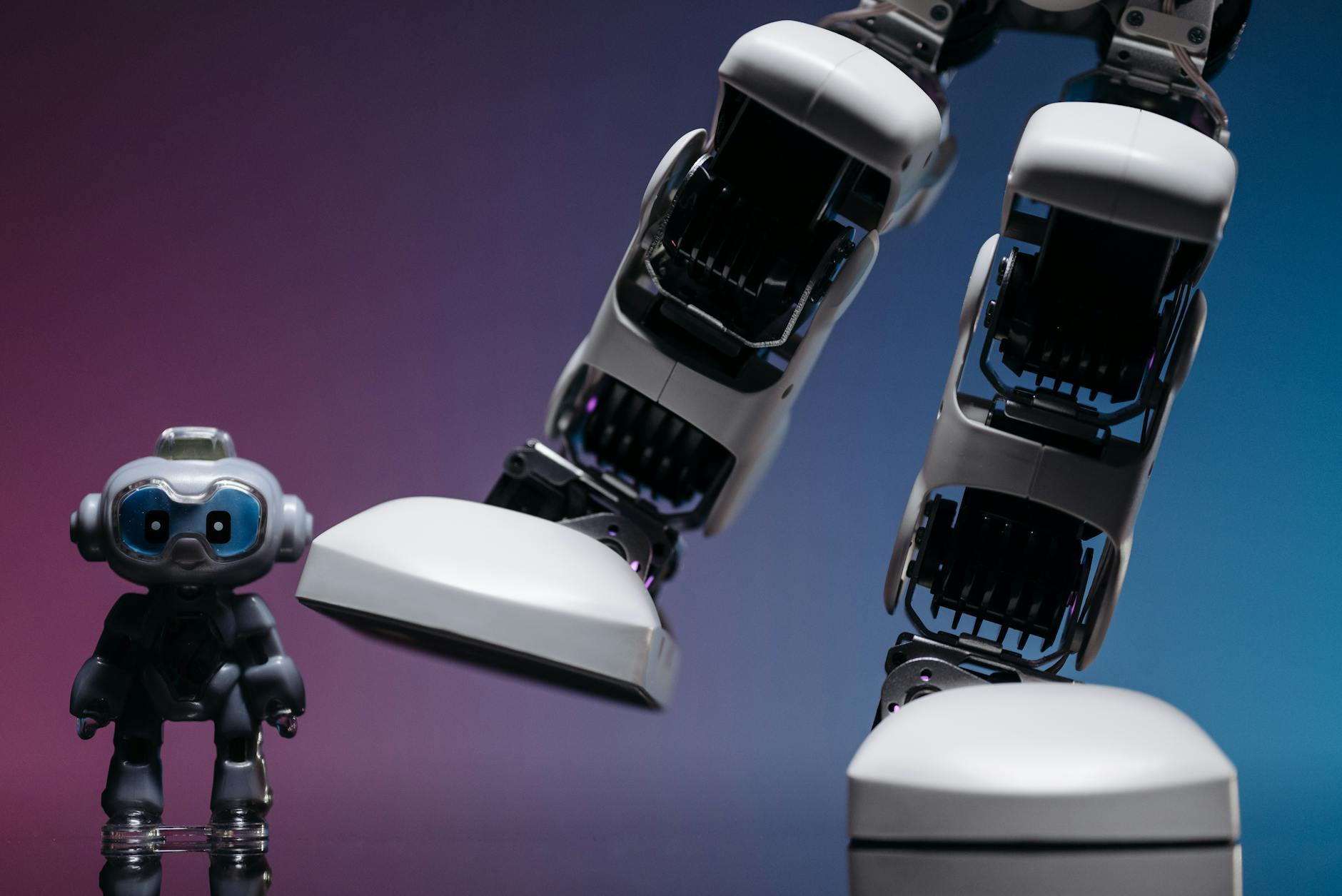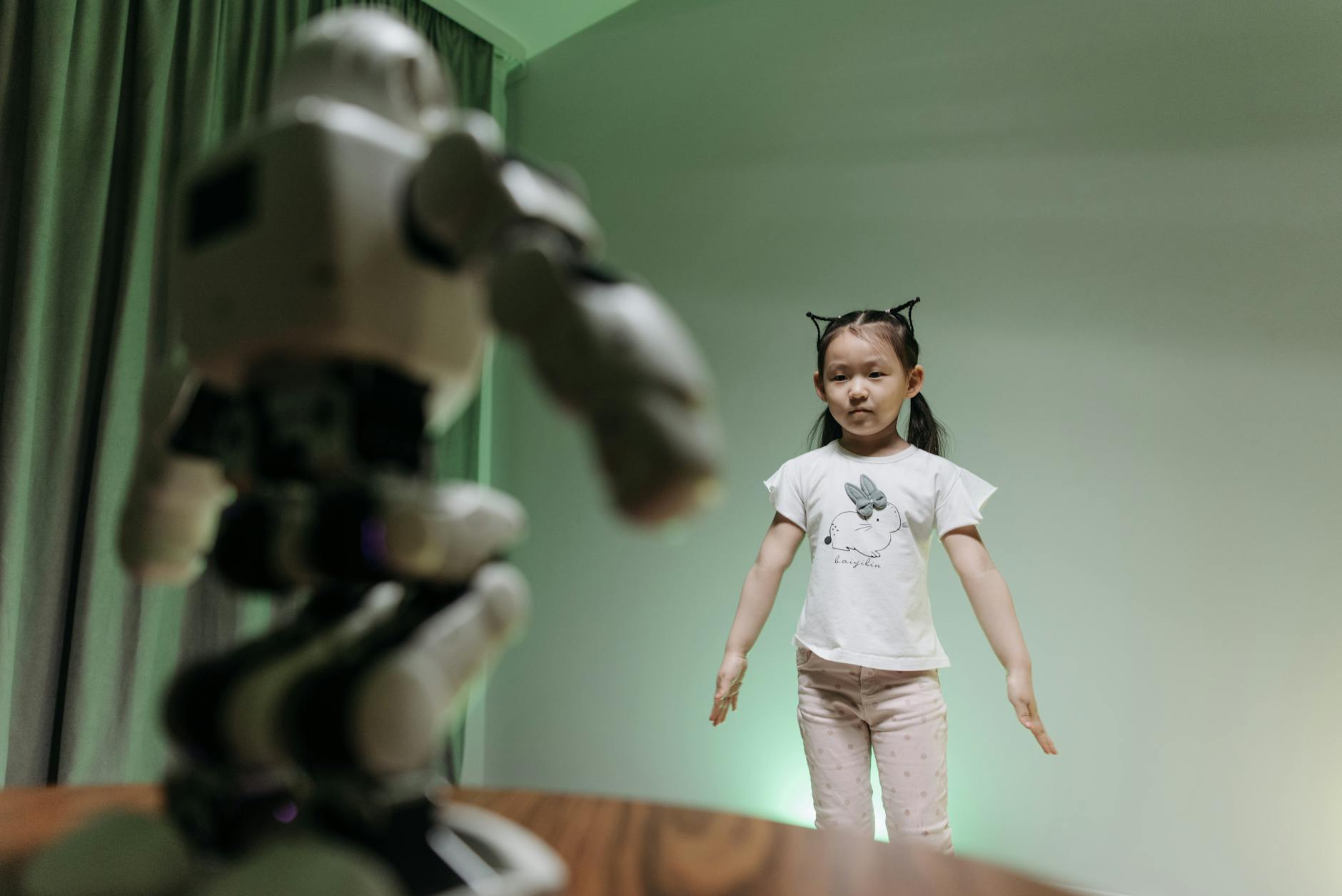The Guide: Artificial Intelligence in Detail
Understanding Artificial Intelligence
General Overview
Ever wondered how a machine can act like a human? That’s artificial intelligence (AI) for you. Imagine a world where computers don’t just sit there computing—they’re learning, thinking, solving problems, making decisions, and even getting creative. AI helps machines do all that. It gives them the mojo to recognize objects, chit-chat with people, soak up new knowledge, give advice like a pro, and drive cars without you touching the wheel (IBM).
What’s intelligence without a dose of AI, right? At its core, AI lets machines, and robots take on tasks we’d typically think only humans could handle: a bit of reasoning here, understanding meaning there, or even learning from what they did last summer.
AI can be thought of as machines that act like humans would, making decisions that usually need a human touch, acting on data right there in the moment, using ultra-smart algorithms (Brookings).
Applications in Various Industries
AI isn’t just a classroom topic; it’s out there in the wild making industries better and faster. It’s like giving a turbo boost to just about everything from how stuff gets done to how businesses run. We’re talking about a market that’s growing like a weed, hitting $327.5 billion in 2021 alone.
| Industry | Applications |
|---|---|
| Agriculture | Farmers are turning into tech wizards with AI, using computer vision and machine learning to check soil health, dish out planting tips, and make harvesting as precise as a bullseye. Plus, it makes the farming process quicker and more efficient. |
| Finance | You know how banks always seem to know more about you than your best friend? Blame AI. It’s ruling in customer service, sniffing out fraud, sizing up borrower risks, and spitting out tailored tips for investors. And yes, robots are already playing the stock market for some folks (Forbes). |
| Healthcare | Doctors get a helping hand from AI, making appointments, transcribing notes, and even assisting in surgery. It digs through medical data, offers a second opinion on scans, and is busy finding new drugs. Can you say healthcare superhero? (Forbes). |
| General | Across the board, AI’s got its hands in everything: decision-making, keeping data safe, hiring top talent, and fueling fresh ideas. It’s like having a secret weapon in your business back pocket, saving you money and time, and giving you that extra push to outshine competitors (LeewayHertz). |
With AI, industries are getting smarter. They’re not just keeping up but stepping ahead, making better choices, cutting down on costs, and coming out winners in their fields.
Ethical Considerations of AI
Artificial intelligence is shaking things up in ways we’ve never seen before. But like all good things, it’s got its cloudy corners. Let’s chat about AI’s ethical side – the good, the bad, and the head-scratchers.
Bias and Discrimination
AI is like that friend who picks up your bad habits – it’s trained on tons of data and ends up with the same biases lurking in there. This can spell trouble in places like hiring, justice, and who gets what in healthcare. The U.S. has already waved the red flag, warning against letting AI keep repeating these patterns. The call to action is clear: clean up the bias to keep things fair.
Where Bias Messes Things Up:
- Who gets hired
- How justice is served
- Who’s looked after in health
- Who gets resources first
Transparency and Accountability
AI can be sneaky, acting like a “black box” – it does its thing, but no one really knows how. This secretiveness makes it a puzzle when something goes wrong. That’s why brains are pushing for more explainable AI, especially where it matters most, like in hospitals or with self-driving cars. The aim? Make AI spill its secrets, so we can trust it more and fix it when it hiccups.
Why Explainable AI?
- Makes it easier to trust AI
- Helps rules and regulations make sense
- Shows us where mistakes come from
- Keeps things open and honest
Ownership Rights and Regulations
AI is getting artsy nowadays – think paintings, music, maybe even books. But who gets the credit? This question messes with ownership laws, leaving lawmakers scratching their heads. As AI sprints ahead of regulations, we need rules to keep it in line, making sure creations don’t end up in legal tug-of-wars.
Ownership Issues in AI:
- Who owns what AI makes
- Copyright and patent struggles
- Selling AI-made stuff
- Who’s on the hook for AI’s moves
| Ethical Head-Scratcher | What’s Going On |
|---|---|
| Bias and Discrimination | AI might carry on society’s biases, messing with fairness in work, legal matters, and handing out services |
| Transparency | AI acts like a “black box,” leaving people in the dark about its choices. Explainable AI tries to shed light on its inner workings |
| Ownership Rights | AI creations stir up questions about who holds the rights, how they can be used commercially, and who’s responsible for their impact |
These ethical issues are a big deal if we want to keep AI out of the doghouse. Tackling bias, cracking open the black box, and sorting out who owns what in AI is how we’ll ride the AI wave without falling off.
Deep Dive into AI Concepts
Let’s take a closer look at the intriguing behind-the-scenes mechanics of artificial intelligence. We’ll shine a light on essentials like Generative AI, Deep Learning, and Neural Networks.
Generative AI
Generative AI, or “gen AI” if you’re in the know, whips up stuff like text, pictures, vids, and tunes based on what you ask it to do. It works by first learning all it can about the world, getting better at certain projects, and continuously fine-tuning itself for top-notch results (IBM).
Key Features
- Creating on Its Own: Once it’s clued in, gen AI can cook up brand new pieces that look and feel just like what it studied.
- Big Brain Models: Picture language models that have gorged on heaps of uncooked data—this is the engine behind most gen AI wonders.
- All Over the Place: You’ll find gen AI strutting its stuff in offices, schools, and ads, but watch out for sticky issues like who owns what and keeping things safe.
Capabilities Table
| What’s Being Made | Details |
|---|---|
| Content Type | Text, Images, Video, Audio |
| Training Data | Mountains of messy data |
| Where It Plays | Business, Education, Marketing, Security |
Deep Learning
Deep Learning is a slice of machine learning pie where artificial minds soak up patterns and make choices. It opens the door to many cool AI tricks, including gen AI itself.
Key Concepts
- Thinkers in Layers: These models have layers upon layers of neurons getting cozy with complex info.
- Learning by Doing: Deep learning models improve by munching through big bundles of data to sharpen their skilliness.
- Where It Works: From spotting cats in photos to understanding your chatty messages and even driving without a human hand.
Benefits
- Spot On: These models hit high accuracy marks, especially with pics and speech.
- Goes Big: Could manage heaps and heaps of data while keeping up with the calculations.
Neural Networks
Neural Networks mimic the web of neurons in a brain, fueling deep learning’s fire with their layered design.
Structure
- First Stop (Input Layer): Gets the raw info.
- Middle Ground (Hidden Layers): Twists and turns the data.
- Show’s End (Output Layer): Gives the final guess or label.
Types
- Convolutional Neural Networks (CNNs): They’re the pros at handling image data.
- Recurrent Neural Networks (RNNs): Ace when it comes to things happening in order, like analyzing data over time or sorting through languages.
Advancements Table
| Type | What It’s Good At | Real-World Use |
|---|---|---|
| CNN | Grid-like data | Image Processing |
| RNN | Sequential data | Time-Series, Natural Language |
Getting cozy with these AI fundamentals helps to demystify this digital wizardry and its many strings to its bow, tackling the challenges of its nuts and bolts in action.
Advancements in AI Technology
Lately, AI’s been on fire, especially with all the cool stuff happening in generative AI and nifty neural networks. If you’re keen on artificial intelligence, there’s some rad stuff to dig into here.
Breakthroughs in Generative AI
Generative AI is the shiny new toy in the AI box. It’s all about creating completely fresh content from text cues—whether it’s writing, images, or tunes. Here’s how it usually plays out:
- Training a Foundation Model: This is where you feed a model tons of data so it gets the smarts it needs for different types of content creation.
- Tuning the Model for Content Creation: You tweak this model so it can nail specific tasks—like crafting lifelike images or banging out smooth prose.
- Continuous Check-ups and Tuning: Just like your phone gets updates, these models get regular tweaks to keep them sharp and on point. (IBM)
Take IBM’s Watsonx.ai, for example. It shows off how generative AI can shake up business by merging AI magic with day-to-day tasks (IBM).
Generative AI isn’t just a tech geek’s fantasy; it’s actually showing up in real places like marketing, schooling, and the arts. Businesses knock out slick marketing stuff, teachers cook up interactive lessons, and artists get a new canvas to play on. But alongside the coolness, there’s a bit of a buzzkill with copyright and security worries (TechTarget).
Neural Network Innovations
Neural networks? They’re the muscle behind a lot of AI tricks. Lately, they’ve been getting way smarter, boosting how AI handles stuff across the board.
| Neural Network Type | What It Does |
|---|---|
| Convolutional Neural Networks (CNNs) | These are like the eagle eyes for images and videos, locking in on details automatically. |
| Recurrent Neural Networks (RNNs) | They’re awesome with sequential data like time ticks and chatting, keeping memories of past inputs. |
| Transformers | Consider these the smarty-pants for language stuff, understanding words in context with a self-attention mechanism. |
Innovations in Transformer Models
Transformers have been the cool kids in the AI block, with models like BERT and GPT-3 flipping the script on language tasks. They understand and generate text with top-notch finesse, killing it at jobs like translating, summarizing, or popping out answers to questions.
Advances in Hardware
New hardware toys like GPUs and TPUs have put neural networks on the fast track, making it quicker and cheaper to train big models.
Remember when Google first popped up, or when Amazon’s recommendations made shopping a no-brainer? Those were big moments for AI, like when Watson took on quiz shows (TechTarget).
These leaps in AI tech are making things better, faster, and available for more people and projects. The future’s looking pretty bright!
AI in Society
Taking a good look at artificial intelligence (AI) and its influence on our everyday lives shows that it’s making waves across all sorts of fields. With its use really ramping up, AI is shaking things up in industries and getting folks talking about what it all means.
Impact on Different Sectors
AI is getting its fingers into just about every pie, making tasks easier, working faster, and boosting organizational output. Experts over at CSU Global predict that AI stuff, from software to gadgets and services, is set to grow by a whopping 16.4% annually in 2021, hitting around $327.5 billion.
Key Sector Impacts:
-
Defense:
- In the world of national defense, AI is the big story, especially with Project Maven doing the heavy lifting by sifting through oodles of surveillance data (Brookings).
-
Economy:
-
Finance:
- Investments in financial AI in the US shot up, nearly totaling $12.2 billion between 2013 and 2014. AI’s lending a hand in making loan decisions, designing personalized investment strategies, handling fast trades, and spotting fraud (Brookings).
-
Business:
- Businesses are leaning into AI for automating jobs like customer service, lead hunts, and quality checks—pulling them off more precisely and rapidly than humans (TechTarget).
| Sector | AI Perk |
|---|---|
| Defense | Project Maven, crunching data |
| Economy | GDP boost, benefits of automation |
| Finance | Loans, portfolios, trades, keeping fraud in check |
| Business | Customer chats, finding leads, quality watch |
Public Discourse on AI
AI is moving fast and people are talking. Discussions swirl around its ethics, economic shake-ups, and how it’s impacting society.
-
Ethical Concerns:
- The chatter often points to biases baked into AI systems because they learn from skewed data. Calls for transparency and responsibility in AI decision-making are getting loud.
-
Economic Impact:
- While some folks fret about AI stealing jobs and feeding unemployment, others say it’ll birth new job types and ramp up productivity.
-
Societal Changes:
- With AI weaving into our everyday, concerns about privacy, autonomy, and how tech mingles with human lives are growing. As AI embeds deeper, we’ll need to set up rules to keep things in check.
Grasping both the techie stuff and broader effects of AI is key to making smart choices and prepping society for a future where AI is as common as morning coffee.
Exploring AI in Different Fields
AI in Farming
AI is shaking things up in the world of farming. Forget guessing games; farmers now have techy sidekicks to help them out. With flashy tools like computer vision and machine learning, AI isn’t just helping farmers spot what’s wrong with the dirt. It’s giving them a playbook for the season and upping their game in the field. Imagine quicker harvests and fewer resources being used, all thanks to AI helping farmers make sense of the data.
| AI Application in Farming | How it Helps |
|---|---|
| Computer Vision | Finding soil issues |
| Machine Learning | Suggesting the best plants to grow |
| Efficiency in Harvesting | Speeding up the crop collection process |
AI in Medicine
The doc’s office is another space where AI’s pulling out all stops. Machine learning digs into mountains of data, making diagnostics a breeze. Docs can now say goodbye to second guesses with tailored treatment plans and custom medicine paths. What’s more, AI systems can flag unusual stuff in scans and lend a hand where it counts in research labs and pharma companies.
| AI Application in Medicine | What it Can Do |
|---|---|
| Diagnostics | Reading medical scans like a pro |
| Treatment Advice | Personalizing patient care |
| Custom Medicine | Forecasting patient scenarios |
AI in Money-Matters
Banking has a tech wiz in its corner now, thanks to AI. Whether it’s fun-chatting with automated helpers or keeping fraudsters at bay, AI’s got the upper hand. It checks if you’re good for a loan, serves up smart investor advice, and manages trades with slick robo-advisors. These tech tricks mean things run smoother, cost less, and make for happier bank-goers.
| AI Application in Money-Matters | What it Does |
|---|---|
| Chatbots | Boosting customer interactions |
| Fraud Protection | Spotting fishy transactions |
| Loan Check | Gauging loan risks |
| Investment Tips | Offering through smart firms |
| Automated Trading | Running the show with robo-advisors |
Artificial smarts are waving a magic wand across industries, making things tick faster and smarter. Watch as AI’s power supercharges some key areas, proving it’s more than just fancy algorithms.
Future Trends in AI
Projected Market Growth
AI isn’t just a buzzword—it’s a rocket set to launch into every corner of our lives. Hold onto your hats because the global AI scene is expected to shoot from $136.6 billion in 2022 to a mind-blowing $1,811.8 billion by 2030. That’s like strapping a jetpack to the economy, with a CAGR of 38.1%!
And let’s not forget the AI software market, poised to hit $22.6 billion by 2025. Businesses worldwide are opening their wallets wide for AI, planning to up their spending from $50 billion this year to $110 billion by 2024. Retail and banking are leading the charge, hungry for what AI has to offer.
| Year | Global AI Market Size (in Billions USD) | AI Software Market (in Billions USD) | Annual Business Spending on AI (in Billions USD) |
|---|---|---|---|
| 2022 | 136.6 | – | 50 |
| 2024 | – | – | 110 |
| 2025 | – | 22.6 | – |
| 2030 | 1,811.8 | – | – |
Technological Developments
AI tech isn’t just crawling along—it’s sprinting like Usain Bolt in the tech world:
-
Generative AI: This one’s growing like a toddler on protein shakes, churning out new stuff like text and art. It’s changing the game in creative and tech sectors, automating tasks that were once thought too complex for a machine brain.
-
NLP (Natural Language Processing): Our digital pals are getting better at chatting with us, reading between the lines and making conversation as smooth as your morning coffee. From virtual assistants to real-time translators, it’s all getting smarter.
-
Computer Vision: Machines are getting eyes, so to speak, interpreting the world as we see it. This tech is a game changer for facial recognition and self-driving cars.
-
Neural Network Innovations: With new setups like transformers in the deep learning mix, neural networks are pushing boundaries—managing bigger, hairier datasets than ever before.
-
Quantum Computing: It’s early days, but pairing quantum computing with AI might just school everyone in the room about processing speed and problem-solving.
With these developments, the global economy could see a $15.7 trillion AI boost by 2030, translating to a 14% increase. The money flood is set to benefit regions like China ($7 trillion) and North America ($3.7 trillion) significantly.
| Region | Projected GDP Increase by 2030 (in Trillions USD) |
|---|---|
| China | 7.0 |
| North America | 3.7 |
| Northern Europe | 1.8 |
| Africa and Oceania | 1.2 |
| Asia (excluding China) | 0.9 |
| Southern Europe | 0.7 |
| Latin America | 0.5 |
As AI keeps getting smarter and stronger, these trends show just how much it’s ready to shuffle the deck across industries and economies everywhere.
AI’s Role in Decision-Making
Artificial intelligence is shaking things up in decision-making across a whole bunch of sectors, from jazzing up the work scene to tackling some pretty tricky ethical puzzles. Grasping these angles helps us get a clearer picture of how AI’s changing the way we roll in today’s world.
Workplace Applications
AI tech is sneaking its way into workplaces everywhere, cranking up the ol’ efficiency and productivity dial. By crunching loads of data and taking on the snooze-worthy tasks, AI lets people zero in on the big stuff that requires a human touch (Harvard Gazette).
-
Recruitment and Hiring:
- Think of AI as the ultimate hiring sidekick, combing through resumes, eyeing up candidates, and checking their chops with machine learning magic. This makes hiring smoother and ensures folks actually fit the jobs they’re being hired for.
-
Productivity Enhancement:
- With AI at the helm, productivity levels soar by ditching the mundane tasks to the machines. Data entry, chatting up customers, and sprucing up processes are all AI territory, freeing up humans to get creative and solve real problems.
-
Management and Operations:
- Management gets a boost with AI-powered analytics, helping them make sharper decisions. By peering into predictive analytics and data insights, they can spot trends, tighten operations, and sharpen their business game plan.
| AI Application | Benefits |
|---|---|
| Recruitment and Hiring | Matches candidates with jobs seamlessly |
| Productivity Enhancement | Frees up time for creative tasks |
| Management and Operations | Elevates strategic decision-making |
Ethical Dilemmas and Challenges
While AI is bringing a load of goodies to decision-making, it tags along some gnarly ethical problems, which need a sharp eye to make sure AI’s being used fair and square.
-
Bias and Discrimination:
- AI sometimes acts like a mirror, copying the biases sitting in its training data. This can snowball into biased outcomes, making things sticky, especially in hiring, loans, or law enforcement (Harvard Gazette).
-
Transparency and Accountability:
- Many AI setups work like secretive wizards, hiding their decision-making in a “black box.” This mystery can muck up accountability, particularly in high-stakes fields like health care or self-driving cars.
-
Ownership Rights and Regulations:
- As AI digs deeper into everyday integration, it stirs up hot debates about who owns what data and the rules of the game. We need solid guidelines to dictate the do’s and don’ts, to keep AI use within ethical lines.
| Ethical Challenge | Concern |
|---|---|
| Bias and Discrimination | Risks copying societal prejudices |
| Transparency and Accountability | Keeps decision processes out of sight |
| Ownership Rights and Regulations | Causes a lack of clarity in data rights |
AI’s double-edged sword in decision-making shows the need to milk its perks while untangling the ethical knots. By understanding and overcoming these hurdles, society can better tap into AI’s treasure chest while dodging any unpleasant surprises.













